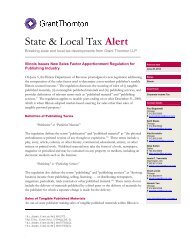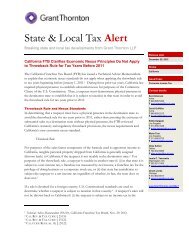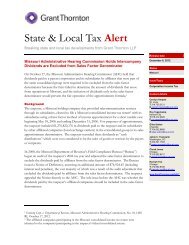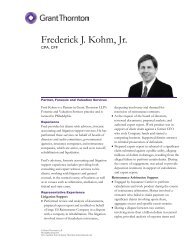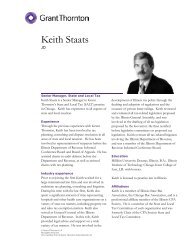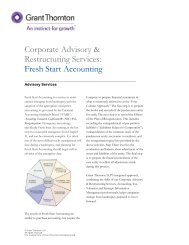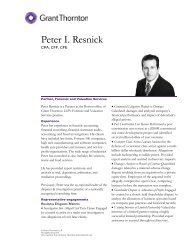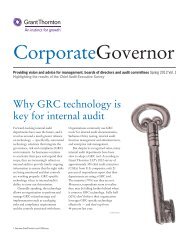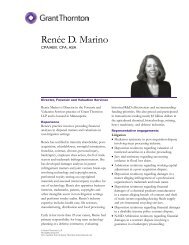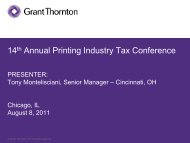Keeping LPs happy: It's a whole new ballgame for private equity
Keeping LPs happy: It's a whole new ballgame for private equity
Keeping LPs happy: It's a whole new ballgame for private equity
Create successful ePaper yourself
Turn your PDF publications into a flip-book with our unique Google optimized e-Paper software.
<strong>Keeping</strong> <strong>LPs</strong> <strong>happy</strong>: It’s a <strong>whole</strong> <strong>new</strong><br />
<strong>ballgame</strong> <strong>for</strong> <strong>private</strong> <strong>equity</strong><br />
Timely topics in <strong>private</strong> <strong>equity</strong> Issue 5<br />
®
About the author<br />
About the sponsors<br />
Jack DiFranco<br />
National Managing Principal, Private Equity<br />
Grant Thornton LLP<br />
Jack DiFranco is the national managing principal <strong>for</strong><br />
Grant Thornton’s Private Equity Services. He also served as national<br />
managing principal <strong>for</strong> Grant Thornton’s Transaction Services Group<br />
as well as Grant Thornton Corporate Finance LLC.<br />
Jack has assisted clients with business acquisitions, divestitures,<br />
recapitalizations, management buyouts, and financing transactions<br />
<strong>for</strong> senior debt, subordinated debt and <strong>equity</strong>. He specializes<br />
in providing M&A advisory services to clients in a variety of<br />
manufacturing and service industries. In addition, he has helped<br />
companies and their shareholders identify and evaluate their<br />
strategic and financial options <strong>for</strong> increasing shareholder value.<br />
Prior to joining Grant Thornton, Jack was a managing director<br />
in the Investment Banking Group of Stout Risius Ross, Inc.<br />
Preceding his experience with SRR, Jack was a member of the<br />
investment banking groups at First of Michigan Corporation<br />
and Ernst & Young Corporate Finance LLP. In these positions,<br />
he provided M&A, financing and transaction advisory services<br />
to corporate acquirers, <strong>private</strong> <strong>equity</strong> firms and middle-market<br />
companies and their shareholders.<br />
Jack has served companies in many industries, including<br />
automotive, building products, in<strong>for</strong>mation technology services,<br />
industrial equipment, health care, business services, software,<br />
distribution, television and radio, education, insurance, retail, and<br />
food processing.<br />
Jack earned an MBA in finance and corporate strategy from<br />
the University of Michigan and a bachelor’s degree in finance from<br />
Oakland University.<br />
The people in the independent firms of Grant Thornton International<br />
Ltd provide personalized attention and the highest quality<br />
service to public and <strong>private</strong> clients in more than 100 countries.<br />
Grant Thornton LLP is the U.S. member firm of Grant Thornton<br />
International Ltd, one of the six global audit, tax and advisory<br />
organizations. Grant Thornton International Ltd and its member<br />
firms are not a worldwide partnership, as each member firm is<br />
a separate and distinct legal entity. Our vision is to be a firm<br />
comprising empowered people providing bold leadership and<br />
distinctive client service worldwide. As such, Grant Thornton<br />
understands the unique needs and strategies of <strong>private</strong> <strong>equity</strong><br />
firms and their professionals. Throughout the life cycle of a fund,<br />
we deliver timely value through our audit, tax and other advisory<br />
services. Visit Grant Thornton LLP at www.GrantThornton.com.<br />
®<br />
The Association <strong>for</strong> Corporate Growth (ACG) is the global<br />
community <strong>for</strong> mergers and acquisitions and corporate growth<br />
professionals, helping connect capital with opportunity. ACG<br />
provides its members with the research, tools and networking<br />
opportunities to grow their businesses and themselves<br />
professionally. Founded in 1954, ACG has grown to more than<br />
13,000 members from corporations, and <strong>private</strong> <strong>equity</strong>, finance<br />
and professional service firms representing Fortune 1000, FTSE<br />
100, and mid-market companies in 56 chapters in North America,<br />
Europe and Asia. For more in<strong>for</strong>mation, visit www.acg.org.
Introduction<br />
To say the last few years in the M&A business have been a roller-coaster<br />
ride is an understatement. I know that many of my peers who have been<br />
in the business <strong>for</strong> 20-plus years agree. At the beginning of 2011, we<br />
were eager to start the <strong>new</strong> year and looking <strong>for</strong>ward to a more stable<br />
deal-making environment. That said, while transaction market conditions<br />
continuously improved during 2010, 2011 has brought on a <strong>whole</strong> <strong>new</strong> set<br />
of challenges <strong>for</strong> <strong>private</strong> <strong>equity</strong> professionals. Many <strong>private</strong> <strong>equity</strong> firms<br />
deferred fundraising until market conditions improved. With the slight<br />
recovery we have seen, <strong>private</strong> <strong>equity</strong> firms were expected to flood the<br />
market looking <strong>for</strong> capital this year. However, with limited partners (<strong>LPs</strong>)<br />
remaining somewhat cautious about investing, many <strong>private</strong> <strong>equity</strong> firms<br />
are faced with the prospect of not being able to raise a <strong>new</strong> fund in 2011<br />
or, <strong>for</strong> some, ever again. Needless to say, the implications of this could<br />
be widespread. New regulatory requirements that go into effect in July<br />
<strong>for</strong> <strong>private</strong> <strong>equity</strong> firms will also change the landscape. This white paper<br />
explores the current fundraising climate, what <strong>LPs</strong> expect from <strong>private</strong><br />
<strong>equity</strong> partnerships going <strong>for</strong>ward, and how regulatory issues will affect<br />
<strong>private</strong> <strong>equity</strong> firms and the industry in the future.<br />
To explore these issues, we spoke with professionals who focus on<br />
various elements of the <strong>private</strong> <strong>equity</strong> industry. These specialists include<br />
<strong>LPs</strong>, general partners (GPs), regulatory professionals and fund managers.<br />
In addition, Grant Thornton LLP searched many data points, including<br />
those from PitchBook Data Inc. (PitchBook), Dealogic, Standard &<br />
Poor’s, and Probitas Partners. Through these sources — and original<br />
reporting — Grant Thornton provides readers with the context of the<br />
current fundraising and regulatory environment. In addition, we offer<br />
a candid view of what <strong>LPs</strong> can expect going <strong>for</strong>ward and what’s on<br />
the horizon. In order to preserve confidentiality, we have withheld the<br />
names of <strong>LPs</strong> who agreed to talk with us off the record. This white paper<br />
will give readers a better understanding of how <strong>new</strong> developments may<br />
change the industry and how <strong>private</strong> <strong>equity</strong> firms can meet the increasing<br />
expectations of <strong>LPs</strong> in the context of the current economic and deal<br />
environment.<br />
Contents<br />
1 Introduction<br />
2 Fund per<strong>for</strong>mance and the<br />
economic environment<br />
5 The regulatory environment<br />
7 Alignment of interest<br />
10 Firms that per<strong>for</strong>m<br />
11 Potential solutions<br />
Infrastructure, operational<br />
enhancements, transparency and<br />
better reporting<br />
Industry specialization<br />
Alternative investment strategies<br />
Value creation<br />
16 Concluding thoughts<br />
With limited partners (<strong>LPs</strong>) remaining somewhat cautious about investing, many <strong>private</strong><br />
<strong>equity</strong> firms are faced with the prospect of not being able to raise a <strong>new</strong> fund in 2011 or,<br />
<strong>for</strong> some, ever again.<br />
<strong>Keeping</strong> <strong>LPs</strong> <strong>happy</strong>: It’s a <strong>whole</strong> <strong>new</strong> <strong>ballgame</strong> <strong>for</strong> <strong>private</strong> <strong>equity</strong> 1
Fund per<strong>for</strong>mance and the economic<br />
environment<br />
After emerging from one of the most difficult economic<br />
environments in history, most <strong>private</strong> <strong>equity</strong> professionals had<br />
started to feel a little more confident by the middle of 2010 and<br />
were looking <strong>for</strong>ward to 2011 — and rightfully so. Companies<br />
that had held out on selling started to creep back into the<br />
market in 2010, and by the end of last year, deal volume had<br />
picked up significantly. In 2010, <strong>private</strong> <strong>equity</strong> deal volume<br />
reached $195.7 billion globally, up 53 percent over 2009’s total<br />
of $105 billion. The fourth quarter alone saw $57.8 billion<br />
worth of <strong>private</strong> <strong>equity</strong> deals get completed, according to<br />
Dealogic.<br />
What’s more, investment banks saw $9.9 billion worth<br />
of revenues come from advisory work on behalf of financial<br />
sponsors, according to Dealogic. That was more than twice the<br />
$4.4 billion generated in 2009. The data leaves no question that<br />
<strong>private</strong> <strong>equity</strong> activity began rebounding in 2010. That’s the<br />
good <strong>new</strong>s. However, regulatory changes and difficulty raising<br />
<strong>new</strong> funds are two obstacles facing dealmakers today.<br />
After aggressively putting money to work during the<br />
2004 through 2007 period, <strong>private</strong> <strong>equity</strong> firms that raised<br />
capital during that same period now need to raise <strong>new</strong> funds.<br />
According to PitchBook, <strong>private</strong> <strong>equity</strong> funds globally raised<br />
only $148 billion in 2009, 54 percent less than they did in 2008.<br />
2010 wasn’t great either; only $90 billion of capital was raised<br />
during the year (see Figure 1). Funds that would normally have<br />
raised capital in 2009 and 2010 postponed fundraising in hopes<br />
of launching <strong>new</strong> funds in more favorable market conditions.<br />
Now that dealmakers are seeing a marked improvement,<br />
2011 is expected to be a crowded fundraising market. In fact,<br />
globally there are about 700 <strong>private</strong> <strong>equity</strong> and venture capital<br />
funds either already in the market or expected to be in the<br />
market to raise funds during 2011. They are all competing <strong>for</strong><br />
the same dollars to be doled out by <strong>LPs</strong>.<br />
Figure 1<br />
Private <strong>equity</strong> fundraising by year<br />
Number of<br />
funds closed<br />
300<br />
Capital raised ($B)<br />
Number of funds closed<br />
Capital raised<br />
$ in billions<br />
$350<br />
250<br />
$300<br />
Companies that had held out on selling<br />
started to creep back into the market in<br />
2010, and by the end of last year, deal<br />
volume had picked up significantly.<br />
200<br />
150<br />
100<br />
$250<br />
$200<br />
$150<br />
$100<br />
50<br />
$50<br />
0<br />
0<br />
2000 2001 2002 2003 2004 2005 2006 2007 2008 2009 2010<br />
Source: PitchBook Data Inc.<br />
2 <strong>Keeping</strong> <strong>LPs</strong> <strong>happy</strong>: It’s a <strong>whole</strong> <strong>new</strong> <strong>ballgame</strong> <strong>for</strong> <strong>private</strong> <strong>equity</strong>
With all the pent-up demand <strong>for</strong> <strong>new</strong> capital, <strong>private</strong> <strong>equity</strong><br />
firms are finding that <strong>LPs</strong> are firmly in control these days;<br />
<strong>LPs</strong> aren’t quickly <strong>for</strong>getting the challenges that arose during<br />
the 2005–2007 time period that left them less than enthusiastic<br />
about <strong>private</strong> <strong>equity</strong> firms <strong>for</strong> most of 2009 and 2010. As a result<br />
of <strong>private</strong> <strong>equity</strong> firms being able to raise a record amount of<br />
capital and the wide-open leverage markets, many firms paid<br />
aggressively <strong>for</strong> the companies they purchased. As expected<br />
(with the benefit of hindsight), this is already negatively affecting<br />
returns. Private <strong>equity</strong> vintage funds from 2007, <strong>for</strong> example, are<br />
showing an average internal rate of return (IRR) of negative 14<br />
percent. Mezzanine funds from the same year are showing an<br />
average IRR of negative 32 percent (see Figure 2).<br />
It’s not all bad <strong>new</strong>s, though. In fact, <strong>LPs</strong>’ sentiments toward<br />
<strong>private</strong> <strong>equity</strong> are actually becoming more positive than they<br />
have been in recent years, especially toward middle-market<br />
funds. According to a survey conducted by Probitas Partners at<br />
the end of 2010, Private Equity Market Review and Institutional<br />
Investor Trends Survey <strong>for</strong> 2011, 46 percent of respondents plan<br />
to focus their attention in 2011 on investing in middle-market<br />
($500 million to $2.5 billion) buyout funds (see Figure 3).<br />
Figure 3<br />
Private <strong>equity</strong> sectors of interest<br />
During 2011, I plan to focus most of my attention on investing in the<br />
following sectors: (choose no more than five)<br />
Figure 2<br />
Average internal rate of return <strong>for</strong> U.S.-based funds<br />
PE<br />
Mezzanine<br />
Internal rate of return<br />
25%<br />
20%<br />
15%<br />
10%<br />
5%<br />
0<br />
-5%<br />
-10%<br />
-15%<br />
-20%<br />
-25%<br />
-30%<br />
-35%<br />
1998 1999 2000 2001 2002 2003 2004 2005 2006 2007 2008 2009 2010<br />
Vintage<br />
Source: Pitchbook Data Inc.<br />
It’s not surprising that <strong>LPs</strong> have pulled back on their<br />
allocations, as evidenced by the already changed fundraising<br />
environment. For example, in 2007, The Blackstone Group<br />
raised a $21.7 billion fund, the largest <strong>private</strong> <strong>equity</strong> fund ever<br />
raised. But its latest fund, Blackstone Capital Partners VI, held a<br />
final close of just $13.5 billion in July 2010. Madison Dearborn<br />
Partners set out to raise a $10 billion fund in 2008. After 28<br />
months, the firm closed on roughly $4.1 billion, far below its<br />
revised target of $7.5 billion set in the summer of 2008.<br />
U.S. middle-market buyouts ($500 MM-$2.5 B)<br />
Growth capital funds<br />
U.S. small-market buyouts ($5 B)<br />
Timber funds<br />
European/Israeli venture capital<br />
Source: Probitas Partners<br />
46<br />
39<br />
37<br />
33<br />
30<br />
27<br />
25<br />
22<br />
19<br />
19<br />
18<br />
17<br />
15<br />
13<br />
13<br />
11<br />
9<br />
9<br />
8<br />
5<br />
4<br />
2<br />
<strong>Keeping</strong> <strong>LPs</strong> <strong>happy</strong>: It’s a <strong>whole</strong> <strong>new</strong> <strong>ballgame</strong> <strong>for</strong> <strong>private</strong> <strong>equity</strong> 3
However, the number of <strong>private</strong> <strong>equity</strong> firms that are able<br />
to raise capital will likely diminish overall, and there will be<br />
a divide between firms that can raise <strong>new</strong> funds and those<br />
that can’t. “Fundraising will be subjective based on the GP.<br />
There will be a growing divide between the haves and havenots.<br />
Fundraising will be very easy <strong>for</strong> some because they<br />
have had spectacular track records and a loyal LP base. These<br />
firms won’t have to make huge concessions either,” says<br />
Erik Hirsch, chief investment officer <strong>for</strong> investment adviser<br />
and funds-of-funds manager Hamilton Lane, whose clients<br />
include MassPRIM, the state of Washington and the United<br />
Brotherhood of Carpenters. “Then there’s another group<br />
<strong>for</strong> which none of this is true. These firms are having serious<br />
problems, which will eventually lead to a weeding out in the<br />
market.”<br />
It’s important to note that even the firms that can’t raise<br />
<strong>new</strong> funds will not go away immediately — we won’t see<br />
the wind-down of those funds <strong>for</strong> another five years. “It’s a<br />
slow death,” warns Kelly DePonte, a senior professional with<br />
placement agent Probitas Partners. “In the venture capital<br />
industry you saw a ton of funds raised in 1999 and 2000 that<br />
didn’t finally decide to wind down until 2007 or later. I think<br />
about 10 percent to 15 percent of <strong>private</strong> <strong>equity</strong> firms may<br />
disappear, but it will happen slowly.”<br />
If a <strong>private</strong> <strong>equity</strong> firm raised its most recent fund in<br />
2006, it should be raising its next fund in 2011. Even if a firm<br />
can’t raise a <strong>new</strong> fund <strong>for</strong> three years and isn’t making <strong>new</strong><br />
investments, it will still be managing some portfolio companies<br />
bought with its previous fund. It won’t be until 2014 or 2015<br />
that these <strong>private</strong> <strong>equity</strong> firms will finally cease operations.<br />
As an aside, with fewer firms in business and the size of<br />
some firms potentially smaller, it only stands to reason that<br />
there will be a decrease in investment professionals’ headcount<br />
over time as well. “We are expecting fewer professionals to<br />
staff the firms, but this isn’t necessarily a bad thing. It will help<br />
bring down administrative costs associated with being a larger<br />
fund which the <strong>LPs</strong> ultimately pay <strong>for</strong>,” says one LP, referring<br />
to the fees they pay <strong>private</strong> <strong>equity</strong> firms to manage their assets.<br />
It’s important to note that even the<br />
firms that can’t raise <strong>new</strong> funds will not<br />
go away immediately — we won’t see<br />
the wind-down of those funds <strong>for</strong> another<br />
five years.<br />
4 <strong>Keeping</strong> <strong>LPs</strong> <strong>happy</strong>: It’s a <strong>whole</strong> <strong>new</strong> <strong>ballgame</strong> <strong>for</strong> <strong>private</strong> <strong>equity</strong>
The regulatory environment<br />
In addition to dealing with a more difficult fundraising<br />
environment, <strong>private</strong> <strong>equity</strong> firms must meet the requirements<br />
of the Private Fund Investment Advisers Registration Act,<br />
which was signed into law on July 21, 2010, as part of the<br />
Dodd-Frank Wall Street Re<strong>for</strong>m and Consumer Protection<br />
Act (the Dodd-Frank Act). The <strong>new</strong> legislation requires<br />
advisers of <strong>private</strong> <strong>equity</strong> and hedge funds with more than<br />
$150 million of assets under management to register with the<br />
SEC by July 21, 2011, which is quickly approaching. (Venture<br />
capital funds were given a pass.) The Dodd-Frank Act was put<br />
in place to promote the financial stability of the United States<br />
by improving accountability and increasing transparency in<br />
the financial system. While the largest <strong>private</strong> <strong>equity</strong> firms will<br />
most likely face greater scrutiny from the SEC, all firms that<br />
will be required to register with the SEC should do so and<br />
prepare themselves now <strong>for</strong> SEC inspections.<br />
Every registered firm is required to appoint a chief<br />
compliance officer (CCO) to maintain the firm’s books and<br />
records, which will be subject to SEC examination as the<br />
agency sees fit. Private <strong>equity</strong> firms will need to have a <strong>for</strong>mal<br />
compliance policy, in addition to keeping track of their assets<br />
under management, use of leverage, counterparty credit risk<br />
exposure, trading and investment positions, valuation policies<br />
and practices, types of assets held, side arrangements with <strong>LPs</strong>,<br />
and trading practices, if applicable.<br />
Additionally, there is a required change in sales materials,<br />
and more disclosures from <strong>private</strong> <strong>equity</strong> firms will be needed.<br />
As part of registration, Form ADV Parts 1 and 2 must be<br />
filed. “We are finding that many <strong>private</strong> <strong>equity</strong> firms don’t<br />
have these things in place,” says Steven Goldberg, a principal<br />
in Grant Thornton’s Business Advisory Services practice.<br />
“However, as partners came back from the holiday at the<br />
beginning of January, they started realizing that they have to<br />
take this seriously. We are now getting more and more calls<br />
about registering, every day.”<br />
Some experts estimate the cost associated with registering<br />
to be about $250,000 <strong>for</strong> a smaller firm; however, costs can<br />
vary widely depending on how in-depth a firm gets with its<br />
registration and how prepared it is when beginning the process.<br />
Appointing a CCO is the first step toward satisfying the<br />
requirements set <strong>for</strong>th by the SEC. The CCO can be a fulltime<br />
person or someone who is outsourced — the cost is<br />
expected to be roughly the same regardless of which route a<br />
firm takes. The CCO should not be one of the firm’s partners.<br />
“It shouldn’t be someone who gets paid off the proceeds of the<br />
firm’s investments. That creates a conflict,” warns Goldberg.<br />
“The CCO should be someone who is knowledgeable,<br />
competent, empowered by the firm and up to speed on<br />
registration requirements.”<br />
While the largest <strong>private</strong> <strong>equity</strong> firms<br />
will most likely face greater scrutiny from<br />
the SEC, all firms that will be required<br />
to register with the SEC should do so<br />
and prepare themselves now <strong>for</strong> SEC<br />
inspections.<br />
<strong>Keeping</strong> <strong>LPs</strong> <strong>happy</strong>: It’s a <strong>whole</strong> <strong>new</strong> <strong>ballgame</strong> <strong>for</strong> <strong>private</strong> <strong>equity</strong> 5
Next, the CCO has to have the firm ready <strong>for</strong> SEC<br />
inspection, which is a periodic examination of the firm’s books<br />
and records. The ADV <strong>for</strong>ms are where the initial process<br />
really begins. Filling out the first part of the ADV <strong>for</strong>m is<br />
easy. It requires general in<strong>for</strong>mation such as ownership and<br />
control, regulatory, disciplinary history, and balance sheet<br />
in<strong>for</strong>mation, along with additional in<strong>for</strong>mation about the<br />
business. The second part is more complex. Private <strong>equity</strong><br />
firms are required to create a narrative brochure that provides<br />
in<strong>for</strong>mation such as affiliations, conflicts, fees charged,<br />
investment strategies, and specifics on the adviser’s past<br />
per<strong>for</strong>mance and services. This material needs to be updated<br />
annually and delivered to current and potential clients.<br />
“A lot of firms think the process ends with their <strong>new</strong>ly<br />
appointed CCO filling out the ADV <strong>for</strong>m. But that’s where<br />
the process really begins. The in<strong>for</strong>mation in the <strong>for</strong>m needs<br />
to be accurate, and firms have to live by the in<strong>for</strong>mation they<br />
put in there. Inaccurate, misleading or omitted disclosures<br />
could lead to regulatory action, which will not look good on a<br />
firm’s track record,” says Michael Patanella, an Audit partner<br />
in Grant Thornton’s Financial Services practice.<br />
Because there will be several thousand <strong>new</strong> funds<br />
registering, observers are speculating that the SEC will not<br />
get to every firm immediately. “The SEC will probably look<br />
at the larger funds first and the funds with troubled assets<br />
or ones that have had regulatory issues in the past,” says<br />
Goldberg. “But that doesn’t mean a squeaky-clean smaller<br />
firm shouldn’t be ready because the SEC could just as easily<br />
inspect those firms too.”<br />
In fact, to deal with the influx of <strong>new</strong> registrants, the SEC<br />
recently asked Congress to <strong>for</strong>m a separate organization<br />
that can examine the <strong>private</strong> <strong>equity</strong> firms and hedge funds<br />
registering. While how the SEC plans to deal with all the<br />
<strong>new</strong> registrants is not yet sorted out, <strong>private</strong> <strong>equity</strong> firms that<br />
comply early on will be in better standing in the long run, not<br />
just with the SEC, but with <strong>LPs</strong> as well. “I don’t want to say<br />
that a blemish on a <strong>private</strong> <strong>equity</strong> firm’s record with the SEC<br />
will cause the firm to close its doors, but it would certainly<br />
be looked at negatively by the <strong>LPs</strong> and could certainly slow<br />
money from coming into a fund,” says Patanella.<br />
While how the SEC plans to deal with<br />
all the <strong>new</strong> registrants is not yet sorted<br />
out, <strong>private</strong> <strong>equity</strong> firms that comply<br />
early on will be in better standing in the<br />
long run, not just with the SEC,<br />
but with <strong>LPs</strong> as well.<br />
6 <strong>Keeping</strong> <strong>LPs</strong> <strong>happy</strong>: It’s a <strong>whole</strong> <strong>new</strong> <strong>ballgame</strong> <strong>for</strong> <strong>private</strong> <strong>equity</strong>
Alignment of interest<br />
These three words have been thrown into the <strong>private</strong> <strong>equity</strong><br />
discussion <strong>for</strong> the past several years. And while many believe<br />
those words are overused, <strong>LPs</strong> still care very much about<br />
alignment. Alignment of interest really comes down to a<br />
feeling that all parties are sharing the risks and benefits of the<br />
relationship in a fair and appropriate way.<br />
Many <strong>LPs</strong> believe that GPs gained too much power over<br />
them during the boom years, and now they are trying to take<br />
back some power and are making their demands clear. At<br />
the heart of the issue is fee structure. When raising very large<br />
funds, <strong>private</strong> <strong>equity</strong> firms were able to charge significant fees<br />
to manage LP assets, and the fees were not based on return<br />
on investment. Granted, the problem had a greater effect on<br />
the larger <strong>private</strong> <strong>equity</strong> firms because they generated higherdollar<br />
fees, but middle-market firms are coming under scrutiny<br />
as well.<br />
During the last couple of years, <strong>LPs</strong> felt their alignment<br />
with GPs was out of whack. To deal with the alignment<br />
issues, in September 2009 the Institutional Limited Partners<br />
Association (ILPA) put out Private Equity Principles, a set of<br />
best practices <strong>for</strong> <strong>private</strong> <strong>equity</strong> firms to follow (see page 9).<br />
More than 100 <strong>LPs</strong> have endorsed the principles, which were<br />
revised in January 2011 and fall within three guiding tenets:<br />
governance, transparency and alignment of interest. 1 The goal<br />
of the principles is to make sure that the GPs’ interests are<br />
aligned with those of the <strong>LPs</strong>.<br />
“<strong>LPs</strong> are monitoring their portfolios closely, and so the<br />
Private Equity Principles were published in an ef<strong>for</strong>t to restore<br />
the alignment of interest between GPs and <strong>LPs</strong> that existed<br />
in the original <strong>private</strong> <strong>equity</strong> model. When there is more<br />
emphasis on carry and less on fees, both <strong>LPs</strong> and GPs share<br />
in the upside of the value added to portfolio companies.” says<br />
Kathy Jeramaz-Larson, executive director of the ILPA. “It’s<br />
important <strong>for</strong> the GPs to understand what is important to the<br />
<strong>LPs</strong> as they enter into fundraising.”<br />
Indeed, according to a survey conducted by Probitas<br />
Partners at the end of 2009, 47 percent of <strong>LPs</strong> believed<br />
the management and transaction fees on large funds were<br />
destroying the alignment of interest between fund managers<br />
and investors, and last year 39 percent still said that these same<br />
factors were destroying the alignment of interest between GPs<br />
and <strong>LPs</strong>. What’s more, <strong>LPs</strong> are focusing more heavily on fund<br />
structures, with 53 percent of them saying they are spending<br />
more time focusing on the GPs’ level of financial commitment<br />
to the fund.<br />
When raising very large funds, <strong>private</strong> <strong>equity</strong><br />
firms were able to charge significant fees to<br />
manage LP assets, and the fees were not based<br />
on return on investment.<br />
1<br />
Institutional Limited Partners Association, Private Equity Principles, Version 2.0, January 2011<br />
<strong>Keeping</strong> <strong>LPs</strong> <strong>happy</strong>: It’s a <strong>whole</strong> <strong>new</strong> <strong>ballgame</strong> <strong>for</strong> <strong>private</strong> <strong>equity</strong> 7
GPs are listening. At the end of January, Kohlberg Kravis<br />
Roberts & Co. (KKR) made headlines as it prepared to raise<br />
its <strong>new</strong>est fund, KKR North American XI Fund LP, which is<br />
targeted to raise $8 billion to $10 billion. Its most recent fund,<br />
which brought in $17.6 billion, was raised in 2006. What is<br />
most <strong>new</strong>sworthy about the firm’s <strong>new</strong> fundraising ef<strong>for</strong>t is<br />
that KKR is offering potential investors concessions to invest.<br />
According to The Wall Street Journal, “[f]or the first<br />
time, KKR is giving investors the choice between a lower<br />
management fee and [a] more favorable split on fees charged<br />
to the portfolio companies that the buyout firm purchases,<br />
including transaction and monitoring fees. The firm’s<br />
predecessor vehicle … gave 80 percent of fees charged to<br />
portfolio companies to investors, while 20 percent went to<br />
KKR itself. Now <strong>LPs</strong> … can opt to receive 100 percent of the<br />
fees but must pay a higher management fee, or they can stick<br />
with an 80-20 split without an increase in management fees.” 2<br />
KKR will also include a 7 percent preferred return hurdle<br />
be<strong>for</strong>e the GP receives any of its share of investment profits,<br />
which is something <strong>LPs</strong> have been pushing <strong>for</strong>.<br />
Still, according to most GPs, the ILPA principles have<br />
been a good starting ground <strong>for</strong> <strong>LPs</strong> and GPs to engage in<br />
dialogue about the alignment issue. And with increased ability<br />
to influence fund terms, <strong>LPs</strong> are increasingly identifying issues<br />
that are most important to them, often using those terms as the<br />
final filter when choosing among potential opportunities.<br />
“Investors are really worried about the alignment of<br />
interest,” says Probitas Partners’ DePonte. “The large fees<br />
have really messed things up. To go to the heart of the matter,<br />
GPs can make money even if <strong>LPs</strong> can’t, and it ticks <strong>LPs</strong> off.<br />
Unless your returns have been spectacular, which now about<br />
5 percent of firms can probably claim, <strong>LPs</strong> are asking <strong>for</strong> fee<br />
reductions and better alignment.”<br />
Lots of <strong>private</strong> <strong>equity</strong> firms have started listening. Many of<br />
them have revisited their fee structure, with some even opting<br />
to cut their fees to entice <strong>LPs</strong> to continue investing with them.<br />
It is important <strong>for</strong> <strong>private</strong> <strong>equity</strong> firms to listen to what<br />
the <strong>LPs</strong> are asking <strong>for</strong> and be ready to address management<br />
fees as appropriate. The ILPA guidelines are a good starting<br />
point <strong>for</strong> discussion, but in all of our interviews, we never<br />
came across any <strong>private</strong> <strong>equity</strong> firm that was willing to adopt<br />
all of the principles. Un<strong>for</strong>tunately, because there are about<br />
100 principles, it seems many <strong>private</strong> <strong>equity</strong> firms can’t<br />
endorse them 100 percent. As one GP puts it: “If you ask 10<br />
<strong>LPs</strong> to rank the three principles they care most about, they<br />
all say different things, which makes it hard to please all of<br />
them and makes the principles seem less important. Also, a<br />
GP may comply with 90 percent of the principles, but it’s the<br />
other 10 percent they don’t comply with that one LP cares<br />
about. The guidelines are a starting point <strong>for</strong> open and honest<br />
conversation and need to be treated as such.”<br />
It is important <strong>for</strong> <strong>private</strong> <strong>equity</strong> firms to<br />
listen to what the <strong>LPs</strong> are asking <strong>for</strong> and<br />
be ready to address management fees as<br />
appropriate.<br />
2<br />
Willmer, Sabrina and Dai, Shasha, “KKR Sweetens Terms <strong>for</strong> New Mega Fund,” The Wall Street Journal, Jan. 29, 2011<br />
8 <strong>Keeping</strong> <strong>LPs</strong> <strong>happy</strong>: It’s a <strong>whole</strong> <strong>new</strong> <strong>ballgame</strong> <strong>for</strong> <strong>private</strong> <strong>equity</strong>
ILPA principles<br />
The list of principles initially published by the ILPA in September 2009 and updated<br />
in January 2011 is very comprehensive and includes nearly 100 items.<br />
Below is a select list of principles:<br />
Calculation of carried interest<br />
Alignment is improved when carried interest is<br />
calculated on the basis of net profits (not gross<br />
profits) and on an after-tax basis (i.e., <strong>for</strong>eign or<br />
other taxes imposed on the fund are not treated as<br />
distributions to the partners).<br />
No carry should be taken on current income or<br />
recapitalizations until the full amount of invested<br />
capital is realized on the investment.<br />
Clawbacks<br />
Clawbacks should be created so that when they are<br />
required, they are fully repaid in a timely manner.<br />
The clawback period must extend beyond the term<br />
of the fund, including liquidation and any provision<br />
<strong>for</strong> LP giveback of distributions.<br />
Management fees and expenses<br />
Management fees should be based on reasonable<br />
operating expenses and reasonable salaries, as<br />
excessive fees create misalignment of interests.<br />
During the <strong>for</strong>mation of a <strong>new</strong> fund, the GP should<br />
provide prospective <strong>LPs</strong> with a fee model to be used<br />
as a guide to analyze and set management fees.<br />
Management fees should take into account the<br />
lower levels of expenses generally incident to the<br />
<strong>for</strong>mation of a follow-on fund, at the end of the<br />
investment period, or if a fund’s term is extended.<br />
Expenses<br />
The management fee should encompass all normal<br />
operations of a GP to include, at a minimum,<br />
overhead, staff compensation, travel, deal sourcing<br />
and other general administrative items as well as<br />
interactions with <strong>LPs</strong>.<br />
The economic arrangement of the GP and its<br />
placement agents should be fully disclosed as<br />
part of the due diligence materials provided to<br />
prospective <strong>LPs</strong>. Placement agent fees are often<br />
required by law to be an expense borne entirely by<br />
the GP.<br />
Term of fund<br />
Fund extensions should be permitted in one-year<br />
increments only and be approved by a majority of<br />
the limited partner advisory committee (LPAC) or<br />
<strong>LPs</strong>.<br />
Absent LP consent, the GP must fully liquidate the<br />
fund within a one-year period following expiration of<br />
the fund term.<br />
GP fee income offsets<br />
Transaction, monitoring, directory, advisory [and]<br />
exit fees and other considerations charged by the<br />
GP should accrue to the benefit of the fund.<br />
GP commitment<br />
The GP should have a substantial <strong>equity</strong> interest in<br />
the fund, and it should be contributed in cash as<br />
opposed to being contributed through the waiver of<br />
management fees.<br />
GPs should be restricted from transferring their<br />
real or economic interest in the GP in order to<br />
ensure continuing alignment with the <strong>LPs</strong>.<br />
The GP should not be allowed to co-invest in select<br />
underlying deals; rather, its <strong>whole</strong> <strong>equity</strong> interest<br />
shall be via a pooled fund vehicle.<br />
Team<br />
The investment team is a critical consideration in<br />
making a commitment to a fund. Accordingly, any<br />
significant change in that team should allow <strong>LPs</strong> to<br />
reconsider and reaffirm positively their decision to<br />
commit.<br />
Investment strategy<br />
The fund’s strategy must be well-defined and<br />
consistent.<br />
The investment purpose clause should clearly and<br />
narrowly outline the investment strategy.<br />
Any authority to invest in debt instruments, publicly<br />
traded securities, and pooled investment vehicles<br />
should be explicitly included in the [agreed-upon]<br />
strategy <strong>for</strong> the fund.<br />
Fiduciary duty<br />
GPs should present all conflicts to the LPAC <strong>for</strong><br />
review and seek prior approval <strong>for</strong> any conflicts<br />
and/or non-arm’s-length interactions or transactions.<br />
A majority of <strong>LPs</strong> must be able to remove the GP<br />
or terminate the fund <strong>for</strong> cause.<br />
Changes to the fund<br />
Given the long-term nature of the <strong>private</strong> <strong>equity</strong><br />
partnership, the fund’s terms and governance must<br />
be well-defined upfront but also be flexible enough to<br />
adapt to changing circumstances. With appropriate<br />
protections <strong>for</strong> the interests of the GP, <strong>LPs</strong> should<br />
have the option to suspend or terminate the fund.<br />
Management and other fees<br />
All fees generated by the GP should be periodically<br />
and individually disclosed and classified in each<br />
audited financial report and with each capital call and<br />
distribution notice.<br />
All fees charged to the fund or any portfolio<br />
company by an affiliate of the GP should also<br />
be disclosed and classified in each audited financial<br />
report.<br />
Capital calls and distribution notices<br />
Capital calls and distributions should provide<br />
in<strong>for</strong>mation consistent with the ILPA Standardized<br />
Reporting Format.<br />
The GP should also provide estimates of quarterly<br />
projections on capital calls and distributions.<br />
FINANCIAL INFORMATION<br />
Annual reports — Funds should provide<br />
in<strong>for</strong>mation consistent with the ILPA Standardized<br />
Reporting <strong>for</strong> Portfolio Companies and Fund<br />
in<strong>for</strong>mation at the end of each year (within 90 days<br />
of year-end) to investors.<br />
Quarterly reports — Funds should provide<br />
in<strong>for</strong>mation consistent with the ILPA Standardized<br />
Reporting <strong>for</strong> Portfolio Companies and Fund<br />
in<strong>for</strong>mation at the end of each quarter (within 45<br />
days of the end of the quarter) to investors.<br />
Portfolio company reports — A fund should<br />
provide a quarterly report on each portfolio company<br />
with the following in<strong>for</strong>mation:<br />
• Amount initially invested in the portfolio company<br />
(including loans and guarantees)<br />
• Any amounts invested in the portfolio company in<br />
follow-on transactions<br />
• A discussion by the fund manager of recent key<br />
events in respect of the portfolio company<br />
• Selected financial in<strong>for</strong>mation (quarterly and<br />
annually) regarding the portfolio company,<br />
including:<br />
- valuation (along with a discussion of the<br />
methodology of valuation),<br />
- revenue (debt terms and maturity),<br />
- EBITDA,<br />
- profit and loss,<br />
- cash position, and<br />
- cash burn rate.<br />
Source: Institutional Limited Partners Association<br />
<strong>Keeping</strong> <strong>LPs</strong> <strong>happy</strong>: It’s a <strong>whole</strong> <strong>new</strong> <strong>ballgame</strong> <strong>for</strong> <strong>private</strong> <strong>equity</strong> 9
Firms that per<strong>for</strong>m<br />
First and <strong>for</strong>emost, the <strong>private</strong> <strong>equity</strong> firms that have per<strong>for</strong>med<br />
well and have a stellar track record will be able to garner attention<br />
from their <strong>LPs</strong>. Top-quartile firms such as TPG Capital, Leonard<br />
Green & Partners, and WL Ross will most likely have an easier<br />
go at fundraising (see Figure 4). According to a recent Probitas<br />
Partners survey, investors are likely to commit slightly more to<br />
<strong>private</strong> <strong>equity</strong> in 2011 than they did in 2010, but the appetite <strong>for</strong><br />
<strong>new</strong> managers is limited; most investors are focused on reviewing<br />
current relationships with strong GPs and re<strong>new</strong>ing with only a<br />
select few. Coming out of the recession, <strong>LPs</strong> have realized they<br />
simply do not have the time or capacity to monitor an extensive<br />
number of GP relationships, so they are placing greater focus on<br />
the relationships they value.<br />
“A lot of <strong>LPs</strong> came out of the downturn realizing they have<br />
too many fund relationships. They are asking themselves, ‘Do<br />
I really need six firms with the same strategy in my portfolio?’<br />
At the core of the issue is <strong>LPs</strong> taking a hard look at which firms<br />
with good track records are additive. It’s not about simply being<br />
different, but being different and being able to per<strong>for</strong>m,” says<br />
Hamilton Lane’s Hirsch.<br />
Lori Campana, a managing director with fund placement<br />
agent Monument Group, agrees. “Fundraising is a challenge, but<br />
it is improving. <strong>LPs</strong> are making commitments, but much more<br />
selectively. They are only reupping with their best managers<br />
and ones that add something really compelling to the mix, like a<br />
regional or sector focus, <strong>for</strong> example,” she says.<br />
Figure 4<br />
Internal rate of return by year 2006 – 2010<br />
Fund name Investor name Vintage Close<br />
date<br />
Fund size<br />
($M)<br />
Walnut Investment Partners I The Walnut Group 2000 02-Jan-04 105.00 120.66%<br />
T3 Partners II TPG Capital 2001 02-Jan-05 378.00 95.40%<br />
GCP Cali<strong>for</strong>nia Fund Leonard Green & Partners 2001 02-Jan-05 50.00 91.00%<br />
In<strong>for</strong>mation Technology Ventures In<strong>for</strong>mation Technology Ventures 1995 02-Jan-99 75.00 89.71%<br />
WLR Recovery Fund II W.L. Ross & Co 2002 02-Jan-06 400.00 79.30%<br />
Providence Equity Partners Providence Equity Partners 1996 02-Jan-00 363.00 78.50%<br />
Permira Europe I Permira 1996 02-Jan-00 890.00 74.50%<br />
Clessidra Capital Partners Fund Clessidra Capital Partners 2005 02-Jan-09 1,100.00 63.70%<br />
Platinum Equity Capital Partners Platinum Equity 2004 02-Jan-08 700.00 60.59%<br />
DLJ Merchant Banking Partners I DLJ Merchant Banking Partners 1992 02-Jan-96 1,000.00 58.10%<br />
Carlyle/Riverstone Global Energy and Power Fund II Riverstone Holdings 2004 02-Jan-08 1,100.00 55.80%<br />
Carlyle/Riverstone Global Energy and Power Fund II The Carlyle Group 2004 02-Jan-08 1,100.00 55.14%<br />
OCM/GFI Power Opportunities Fund II GFI Energy Ventures 2005 02-Aug-09 1,020.00 55.03%<br />
Advent Global Private Equity IV Advent International 2002 11-Jan-06 1,768.69 52.30%<br />
Advent Global Private Equity V Advent International 2005 26-Apr-09 3,235.79 50.80%<br />
First Reserve Fund IX First Reserve 2001 02-Jan-05 1,375.00 48.10%<br />
Lincolnshire Equity Fund III Lincolnshire Management 2005 02-Jan-09 433.00 47.16%<br />
OCM Opportunities Fund IVb Oaktree Capital Management 2002 02-Jan-06 1,340.00 46.50%<br />
Source: Pitchbook Data Inc.<br />
IRR<br />
10 <strong>Keeping</strong> <strong>LPs</strong> <strong>happy</strong>: It’s a <strong>whole</strong> <strong>new</strong> <strong>ballgame</strong> <strong>for</strong> <strong>private</strong> <strong>equity</strong>
Potential solutions<br />
So what will it take to attract <strong>new</strong> investment and keep <strong>LPs</strong><br />
<strong>happy</strong>? Well, not all <strong>LPs</strong>’ needs and expectations are alike.<br />
Certainly investors will have their own specific combination<br />
of concerns and expectations. That said, some common themes<br />
and approaches will resonate with most <strong>LPs</strong>. As previously<br />
discussed, better alignment of interest (including addressing<br />
concerns about management fees) will be important. In<br />
addition, improving infrastructure and operations to reduce<br />
costs and heighten transparency will become an area of focus.<br />
Differentiation through industry specialization and alternative<br />
investment strategies is gaining momentum. And finally,<br />
enhancing per<strong>for</strong>mance through a more proactive approach to<br />
value creation will be required to produce attractive returns in a<br />
very competitive marketplace.<br />
Infrastructure, operational enhancements, transparency and<br />
better reporting<br />
Better infrastructure and operational enhancements as well<br />
as more transparency and faster financial reporting will be<br />
key differentiators <strong>for</strong> <strong>private</strong> <strong>equity</strong> firms. Believe it or not,<br />
registering with the SEC can be beneficial. While registration<br />
may take some time, it will help firms keep better track of their<br />
in<strong>for</strong>mation and in turn help them disseminate it to <strong>LPs</strong> faster.<br />
“Firms that register will be more attractive to investors because<br />
<strong>LPs</strong> will be able to invest in them with more confidence,” says<br />
Grant Thornton’s Goldberg.<br />
Additionally, outsourcing the CCO function could be an<br />
advantage in the long run. As Patanella points out, it takes<br />
the possibility of any conflicts out of the equation, which is<br />
a positive <strong>for</strong> the <strong>private</strong> <strong>equity</strong> firms. “There’s sometimes a<br />
negative connotation when firms do their own books. Firms<br />
are not thrilled about paying outside administrators to handle<br />
this function, but then there’s less of a concern of management<br />
manipulation of transactions and misappropriate of assets,”<br />
says Patanella.<br />
That said, while many <strong>LPs</strong> look at the <strong>new</strong> registration<br />
guidelines as “bogus because the SEC does not have the<br />
resources to en<strong>for</strong>ce them, as a practical matter, registration<br />
can add more structure to <strong>private</strong> <strong>equity</strong> firms, which they,<br />
especially smaller firms, are lacking,” says DePonte.<br />
DePonte goes on to point out that <strong>LPs</strong> don’t really care<br />
about infrastructure per se. They care about getting their hands<br />
on data regarding their investments. “I am not hearing a lot of<br />
<strong>LPs</strong> saying they want to see more infrastructure, but they are<br />
saying they want faster access to in<strong>for</strong>mation,” he says.<br />
While registration (with the SEC) may take<br />
some time, it will help firms keep better track<br />
of their in<strong>for</strong>mation and in turn help them<br />
disseminate it to <strong>LPs</strong> faster.<br />
<strong>Keeping</strong> <strong>LPs</strong> <strong>happy</strong>: It’s a <strong>whole</strong> <strong>new</strong> <strong>ballgame</strong> <strong>for</strong> <strong>private</strong> <strong>equity</strong> 11
Hamilton Lane’s Hirsch agrees. <strong>LPs</strong> are making a greater<br />
push <strong>for</strong> operational enhancements, he says. <strong>LPs</strong> are under<br />
pressure from their pensioners to know more about how<br />
their money is being invested, especially if there’s any type of<br />
irregularity in the market. Illiquid assets like <strong>private</strong> <strong>equity</strong><br />
assets add extra concern. From there, the pressure trickles<br />
down. <strong>LPs</strong> then turn to fund management, demanding accurate<br />
in<strong>for</strong>mation in a timely manner. “<strong>LPs</strong> are under pressure to<br />
let their investors know where their assets are and what their<br />
exposure is. Right now there is a gap between <strong>private</strong> <strong>equity</strong><br />
firms that get this done in an acceptable time frame and those<br />
that lag four weeks with the excuse that they don’t have a CFO<br />
or a back office. <strong>LPs</strong> are absolutely going to make a distinction<br />
and will penalize firms that can’t produce this in<strong>for</strong>mation<br />
when it is requested,” says Hirsch.<br />
For example, be<strong>for</strong>e Monument Group allows any of its<br />
<strong>private</strong> <strong>equity</strong> clients to present funds to <strong>LPs</strong>, it insists that<br />
GPs be prepared to demonstrate their firm’s infrastructure<br />
strength. “<strong>LPs</strong> notice it, comment on it, and are more and more<br />
interested in hearing about it,” says Campana. “We have our<br />
GPs talk very specifically about their back office initiatives and<br />
how they help the firm better manage its portfolio companies.<br />
The next thing <strong>LPs</strong> want to know is how that translates<br />
into returns. Sometimes that’s hard to answer. Some value<br />
additions can actually cost money, but GPs should then be<br />
able to demonstrate how having better reporting technology or<br />
providing more purchasing power to the portfolio companies<br />
has turned into more sales leads or greater demand.”<br />
The bottom line is that a <strong>private</strong> <strong>equity</strong><br />
firm’s job is twofold — to be a good<br />
investor and a good fund manager.<br />
There are companies that can help <strong>private</strong> <strong>equity</strong> firms<br />
organize their financial in<strong>for</strong>mation. In 2005, John Grabski<br />
founded ClearMomentum, a software firm that provides<br />
financial reporting and analysis tools to <strong>private</strong> <strong>equity</strong> firms<br />
so that they can better manage their portfolio companies.<br />
Grabski, CEO of the company, says it’s incredible how<br />
much demand <strong>for</strong> his product, ClearFinancials®, has grown<br />
during the last couple of years. “With macrodrivers like the<br />
Dodd-Frank Act and the push <strong>for</strong> more transparency, there<br />
is a lot of interest in our solution,” says Grabski. “The more<br />
transparency there is in the industry, the less risk there is in<br />
investing in the industry. This will drive more money into the<br />
industry.”<br />
ClearFinancials will typically shorten the average reporting<br />
cycle by 25 days, which means <strong>private</strong> <strong>equity</strong> firms learn<br />
about problems at the portfolio level sooner and can address<br />
them quicker. It also allows <strong>private</strong> <strong>equity</strong> firms to report<br />
in<strong>for</strong>mation about fund per<strong>for</strong>mance to their <strong>LPs</strong> faster and in<br />
a uni<strong>for</strong>m style.<br />
The bottom line is that a <strong>private</strong> <strong>equity</strong> firm’s job is<br />
twofold — to be a good investor and a good fund manager.<br />
Being a good fund manager is something most <strong>LPs</strong> feel GPs<br />
have lacked in the past. Being a good fund manager requires<br />
<strong>private</strong> <strong>equity</strong> firms to have best practices in place concerning<br />
infrastructure, reporting and cost. “The big guys are good at<br />
this because they have been under pressure to disclose more.<br />
More firms need to hire CFOs, invest more in their firm<br />
and give <strong>LPs</strong> timely in<strong>for</strong>mation that’s usable,” says Hirsch.<br />
“Going <strong>for</strong>ward, having infrastructure in place will be a<br />
requirement to play the game. An LP won’t even look at you if<br />
you don’t have it in place.”<br />
12 <strong>Keeping</strong> <strong>LPs</strong> <strong>happy</strong>: It’s a <strong>whole</strong> <strong>new</strong> <strong>ballgame</strong> <strong>for</strong> <strong>private</strong> <strong>equity</strong>
Industry specialization<br />
Going <strong>for</strong>ward, attracting LP investors will require more<br />
differentiation. Industry specialization will endear <strong>private</strong><br />
<strong>equity</strong> firms to <strong>LPs</strong>, but as Hirsch says, the firm’s offering has<br />
to be additive, not just different <strong>for</strong> the sake of being different.<br />
That being the case, over the past five years there’s been a<br />
push toward <strong>private</strong> <strong>equity</strong> firms becoming more specialized.<br />
In fact, according to a Probitas Partners survey, 49 percent of<br />
respondents find middle-market funds focused on operational<br />
improvements and heavily staffed by professionals with<br />
operating backgrounds to be the most attractive funds to invest<br />
in.<br />
“Firms used to be able to use financial engineering and<br />
increase the leverage at a portfolio company, but with less<br />
leverage available this strategy is less likely to be successful. The<br />
only thing that consistently generates value is increasing the<br />
earnings of a portfolio company. The best strategy to increase<br />
earnings is to make positive changes within the portfolio<br />
company. You have to have experienced people onboard<br />
making that happen,” says DePonte.<br />
Successful <strong>private</strong> <strong>equity</strong> firms have begun adding areas<br />
of specialization to their offerings in hopes that operational<br />
efficiencies will help boost returns <strong>for</strong> their funds. For example,<br />
the Riverside Company, historically more of a generalist<br />
firm, has developed specializations in select industries like<br />
healthcare, training and education, franchising, and software.<br />
Fortune magazine reports that in early 2011, “Hal Rosser<br />
announced his departure from Bruckmann, Rosser, Sherrill<br />
& Co., a New York-based <strong>private</strong> <strong>equity</strong> firm that he had cofounded<br />
in 1995 with two other veterans of Citicorp Venture<br />
Capital.” 3 Shortly thereafter, he announced the launch of a<br />
<strong>new</strong> firm called Rosser Capital Partners, which will have a<br />
narrower investment thesis. He told Fortune that he left his old<br />
firm because he wanted to focus on buying companies in the<br />
restaurant, retail and multiunit consumer industries.<br />
Wynnchurch Capital Partners, which is in the midst of<br />
raising Wynnchurch Capital Partners III, is a generalist fund,<br />
but it has special expertise in the areas of manufacturing;<br />
transportation and logistics; energy and power; and business<br />
and industrial services; while Jefferies Capital Partners, which<br />
is raising Jefferies Capital Partners V, touts industry expertise<br />
in distribution and logistics; restaurants; manufacturing;<br />
energy; health care; media and telecom; financial services; and<br />
transportation.<br />
“Being a generalist fund can make people think you will<br />
financially engineer the company, which isn’t what anyone<br />
wants to hear today,” says one LP. “We want to hear that<br />
<strong>private</strong> <strong>equity</strong> firms can make a real difference at the company<br />
level.”<br />
The only thing that consistently generates<br />
value is increasing the earnings of a<br />
portfolio company.<br />
3<br />
Primack, Dan, “Term Sheet: Hal Rosser Talks About His New Firm, and Why It’s Always a Good Time to Buy Restaurants,” Fortune, Jan. 11, 2011<br />
<strong>Keeping</strong> <strong>LPs</strong> <strong>happy</strong>: It’s a <strong>whole</strong> <strong>new</strong> <strong>ballgame</strong> <strong>for</strong> <strong>private</strong> <strong>equity</strong> 13
Alternative investment strategies<br />
Alternative investment strategies will also help differentiate<br />
<strong>private</strong> <strong>equity</strong> firms.<br />
In addition to having some sector-specific expertise, <strong>private</strong><br />
<strong>equity</strong> firms that have flexible mandates may also fare better<br />
with <strong>LPs</strong>. Being able to invest in more than one point in the<br />
capital structure is appealing.<br />
Deerpath Capital Management, founded in 2006 by<br />
James Kirby, Gary Wendt (<strong>for</strong>mer chairman and CEO of<br />
GE Capital), and John Fitzgibbons (founder and chairman<br />
of Integra Group), targets <strong>equity</strong> and debt investment deals<br />
between $2 million and $20 million.<br />
“Having flexibility won’t seal the deal, but it could help,<br />
especially in times like we just went through. Being able to<br />
choose to put debt versus <strong>equity</strong> into a deal can be a real<br />
advantage at certain times,” says one LP.<br />
Private <strong>equity</strong> firms that raise funds with a flexible mandate<br />
will be in a good position to take advantage of minoritystake<br />
investments as well. These types of investments gained<br />
popularity during the last couple of years as fewer sellers<br />
wanted to exit their companies fully during turbulent market<br />
conditions but nevertheless needed some liquidity. For<br />
example, Clearlake Capital, a Chicago-based <strong>private</strong> <strong>equity</strong><br />
firm, is agile enough to invest at all different points of the<br />
capital structure.<br />
For instance, a company in a distressed situation may<br />
need rescue financing to avoid a bankruptcy, but a company<br />
in bankruptcy may decide to sell off all or a portion of its<br />
business, and Clearlake can assist with either. <strong>LPs</strong> see the logic<br />
in this investment thesis. In January 2010, Clearlake was able to<br />
close its first institutional fund with $415 million — an almost<br />
impossible feat today.<br />
“In this market, GPs have to have the ability to work<br />
different points of the capital structure. It is a real benefit,”<br />
says Monument Group’s Campana.<br />
Private <strong>equity</strong> firms that raise funds<br />
with a flexible mandate will be in a<br />
good position to take advantage of<br />
minority-stake investments as well.<br />
14 <strong>Keeping</strong> <strong>LPs</strong> <strong>happy</strong>: It’s a <strong>whole</strong> <strong>new</strong> <strong>ballgame</strong> <strong>for</strong> <strong>private</strong> <strong>equity</strong>
Value creation<br />
And of course, value creation at the portfolio level is key.<br />
Like Kelly DePonte says, <strong>private</strong> <strong>equity</strong> firms need to improve<br />
earnings at the companies they buy. Making fundamental<br />
improvements is really the only sustainable way to do that.<br />
Financial engineering and benefiting from multiple arbitrage<br />
cannot be relied upon in the future to generate favorable<br />
returns.<br />
The topic of portfolio company value creation justifies a<br />
great deal of discussion. In fact, our next ACG white paper will<br />
be focused on this topic. That said, there are some important<br />
factors that should be highlighted here.<br />
• Value creation starts with understanding the key value<br />
drivers in a business. These are the levers that create the<br />
opportunity to enhance value. Sales growth, operating<br />
margin efficiency and (in the case of add-on acquisitions)<br />
synergistic SG&A cost rationalization are all examples of<br />
value drivers.<br />
• Every deal has the potential to be a good deal or a bad deal<br />
— it depends on what you pay <strong>for</strong> it. Aggressively valuing<br />
a business or paying <strong>for</strong> synergies means that the bar <strong>for</strong><br />
creating value is getting raised higher and higher. People<br />
say they don’t pay <strong>for</strong> synergies, but it happens all the time.<br />
• During the deal, everyone is focused on the deal. Not<br />
enough buyers focus on the 100-day plan or how the<br />
pursuit of operational improvements is going to be actively<br />
managed post-transaction. An effective per<strong>for</strong>mance<br />
improvement program (or integration plan, in the case of an<br />
add-on acquisition) is often the key to success.<br />
• Be<strong>for</strong>e a deal is consummated, thorough due diligence must<br />
be undertaken to understand the impact of the value drivers<br />
and challenge the potential achievement of operational<br />
synergies. Proper due diligence is not just about the quality<br />
of the earnings or other financial measures.<br />
Be<strong>for</strong>e a deal is consummated, thorough<br />
due diligence must be undertaken to<br />
understand the impact of the value drivers<br />
and challenge the potential achievement of<br />
operational synergies.<br />
<strong>Keeping</strong> <strong>LPs</strong> <strong>happy</strong>: It’s a <strong>whole</strong> <strong>new</strong> <strong>ballgame</strong> <strong>for</strong> <strong>private</strong> <strong>equity</strong> 15
Concluding thoughts<br />
As an asset class, <strong>private</strong> <strong>equity</strong> will continue to play a<br />
very important role in the economy and the transaction<br />
market. Investors still like and need this asset class. Private<br />
<strong>equity</strong> provides growth capital and succession liquidity to<br />
<strong>private</strong>ly held businesses. Private <strong>equity</strong> has also proven to<br />
be a great home <strong>for</strong> corporate divestitures. However, the<br />
industry is changing. The regulatory environment is getting<br />
more difficult. At the same time, <strong>LPs</strong> are becoming more<br />
demanding. Add to that a very competitive marketplace<br />
and an economy that is moving slower toward recovery<br />
than everyone had hoped — these circumstances all create<br />
challenges as well as opportunities. The <strong>private</strong> <strong>equity</strong> firms<br />
that step up to the challenge and strive to enhance their<br />
operations and distinguish themselves in the eyes of <strong>LPs</strong> will<br />
be successful. This will require a more effective approach to<br />
meeting LP expectations. If <strong>private</strong> <strong>equity</strong> professionals aren’t<br />
clear about what their <strong>LPs</strong> want, they just need to ask. As we<br />
found in our interviews <strong>for</strong> this white paper, they won’t be<br />
too shy about letting you know what they want.<br />
The <strong>private</strong> <strong>equity</strong> firms that step up to<br />
the challenge and strive to enhance their<br />
operations and distinguish themselves in<br />
the eyes of <strong>LPs</strong> will be successful.<br />
16 <strong>Keeping</strong> <strong>LPs</strong> <strong>happy</strong>: It’s a <strong>whole</strong> <strong>new</strong> <strong>ballgame</strong> <strong>for</strong> <strong>private</strong> <strong>equity</strong>
Offices of Grant Thornton LLP<br />
National Office<br />
175 West Jackson Boulevard<br />
Chicago, IL 60604<br />
312.856.0200<br />
Washington National Tax Office<br />
1250 Connecticut Ave. NW, Suite 400<br />
Washington, DC 20036-3531<br />
202.296.7800<br />
Arizona<br />
Phoenix 602.474.3400<br />
Cali<strong>for</strong>nia<br />
Irvine 949.553.1600<br />
Los Angeles 213.627.1717<br />
Sacramento 916.449.3991<br />
San Diego 858.704.8000<br />
San Francisco 415.986.3900<br />
San Jose 408.275.9000<br />
Woodland Hills 818.936.5100<br />
Colorado<br />
Denver 303.813.4000<br />
Florida<br />
Fort Lauderdale 954.768.9900<br />
Miami 305.341.8040<br />
Orlando 407.481.5100<br />
Tampa 813.229.7201<br />
Georgia<br />
Atlanta 404.330.2000<br />
Illinois<br />
Chicago 312.856.0200<br />
Oakbrook Terrace 630.873.2500<br />
Kansas<br />
Wichita 316.265.3231<br />
Maryland<br />
Baltimore 410.685.4000<br />
Massachusetts<br />
Boston 617.723.7900<br />
Michigan<br />
Detroit 248.262.1950<br />
Minnesota<br />
Minneapolis 612.332.0001<br />
Missouri<br />
Kansas City 816.412.2400<br />
St. Louis 314.735.2200<br />
Nevada<br />
Reno 775.786.1520<br />
New Jersey<br />
Edison 732.516.5500<br />
New York<br />
Long Island 631.249.6001<br />
Downtown 212.422.1000<br />
Midtown 212.599.0100<br />
North Carolina<br />
Charlotte 704.632.3500<br />
Raleigh 919.881.2700<br />
Ohio<br />
Cincinnati 513.762.5000<br />
Cleveland 216.771.1400<br />
Oklahoma<br />
Oklahoma City 405.218.2800<br />
Tulsa 918.877.0800<br />
Oregon<br />
Portland 503.222.3562<br />
Pennsylvania<br />
Philadelphia 215.561.4200<br />
South Carolina<br />
Columbia 803.231.3100<br />
Texas<br />
Austin 512.391.6821<br />
Dallas 214.561.2300<br />
Houston 832.476.3600<br />
San Antonio 210.881.1800<br />
Utah<br />
Salt Lake City 801.415.1000<br />
Virginia<br />
Alexandria 703.837.4400<br />
McLean 703.847.7500<br />
Washington<br />
Seattle 206.623.1121<br />
Washington, D.C.<br />
Washington, D.C. 202.296.7800<br />
Wisconsin<br />
Appleton 920.968.6700<br />
Milwaukee 414.289.8200
Document content is not intended to answer<br />
specific questions or suggest suitability of<br />
action in a particular case. For additional<br />
in<strong>for</strong>mation on the issues discussed in this<br />
document, consult your Grant Thornton<br />
client-service professional.<br />
In the U.S., visit Grant Thornton LLP at<br />
www.GrantThornton.com.<br />
© Grant Thornton LLP<br />
All rights reserved<br />
U.S. member firm of Grant Thornton International Ltd




